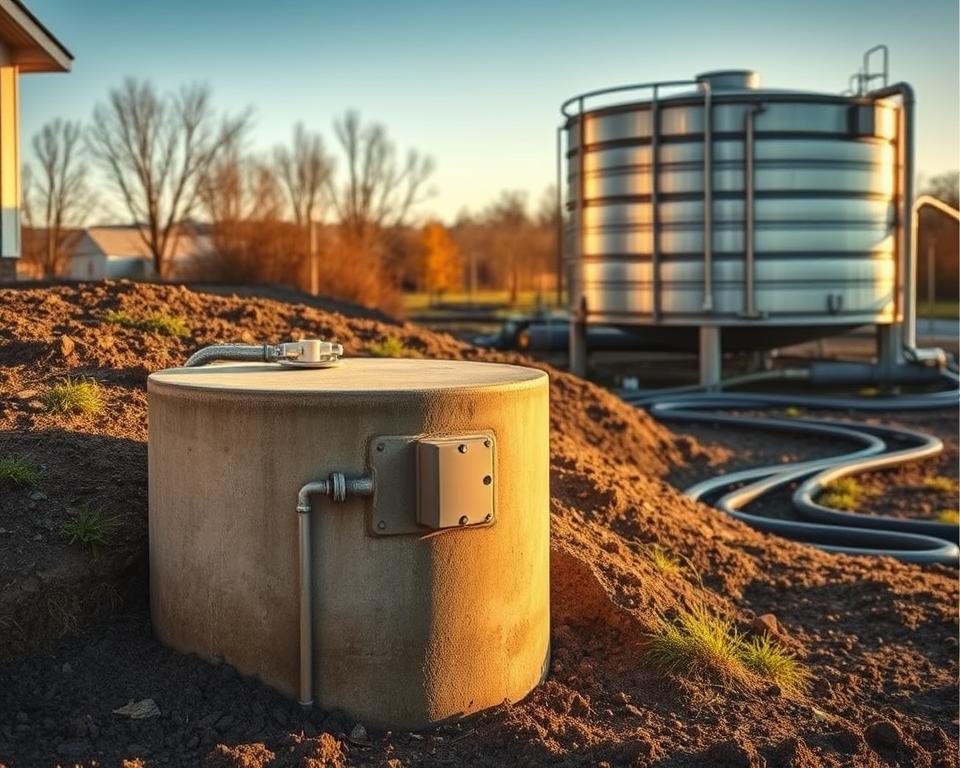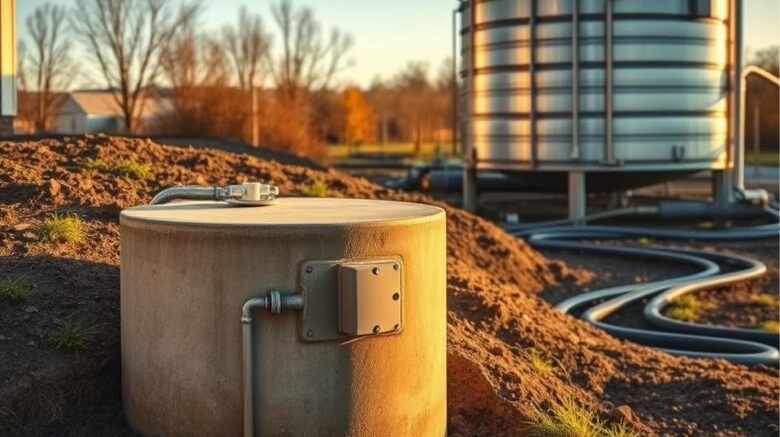Septic Air Pump: Essential Guide for Householders
Ever pondered on what drives your air-treated Septic system’s output? The aeration Pump is the unsung key component crucial for your system. With this resource, property owners will gain essential information on the aerator’s importance. It’s necessary for a robust, well-run Septic tank.
Knowing the significance of a Septic tank air Pump can improve your Septic system’s capabilities using septic tank inspection near me. It also safeguards your asset value and surrounding ecosystem. Our handbook will present All in Sanitation, a trusted Septic industry leader. They’re equipped to fulfil your Septic aerator Pump requirements.
Important Discoveries
- The Septic air Pump is paramount for air-driven Septic tanks.
- Looking after your Septic system air Pump can boost overall system operation.
- Periodic reviews prolong the durability of your Septic tank air Pump.
- Choosing the right Septic aerator Pump is critical for peak operation.
- All in Sanitation offers dedicated services for Septic air Pump solutions.
Getting to Know Aerobic Septic Units
Aerobic Septic systems offer a higher-efficiency waste treatment approach by utilizing oxygen. This technique employs aerobic bacteria thriving in well-oxygenated environments. These bacteria are better in digesting organic matter. With the help of Septic aerator Pumps, these systems deliver a constant oxygen supply, boosting the waste decomposition process.
These systems excel in reducing sludge buildup, thanks to the activity of aerobic bacteria. This drop in solid waste means reduced upkeep and periodic Pump service is necessary. Additionally, they reliably process wastewater, leading to reduced odors. This produces a healthier environment for homeowners and the community as a whole.
To confirm these systems work efficiently, it’s essential to understand the key Septic system components. These include the Septic tank, aeration chamber, and effluent Pump. Each element plays an important part, especially the air Pump. It pushes oxygen into the tank, central for the aerobic bacteria’s activity.
Importance of the Septic Air Pump
The Septic air Pump is central in the running of aerobic Septic systems. It operates as the system’s “oxygen source,” delivering the necessary oxygen essential. This oxygen allows aerobic bacteria to operate efficiently and break down waste effectively. If the Pump fails, the system’s performance declines, leading to sludge increase and possible odors.
Such issues can disrupt Septic system operations and lead to environmental hazards. By recognizing how important the Septic air Pump is, homeowners can take proactive steps. They can keep its optimal function through consistent upkeep. This avoids failures, reduces costly repairs, and preserves the aerobic system’s integrity.
Major Benefits of Using a Septic Air Pump
Utilizing a Septic air Pump significantly boosts the capability of Septic systems. Septic air Pumps are crucial as they quicken the processing of waste. This is achieved by oxygenating the treatment process, encouraging aerobic bacteria growth. These bacteria are vital for successful waste treatment.
They’re also instrumental in cutting foul smells. Thanks to more active aerobic processes, waste breaks down faster, thus cutting down odors. This creates a nicer atmosphere for homeowners.
Another valuable benefit is the decrease in sludge formation. Consequently, tanks necessitate less frequent Pumping, saving both money and time. Greater processing not only reduces spending but also increases the lifespan of the drain field.
Looking after these Pumps diligently means reduced repair costs and adhering to regulatory standards. Thus, the upsides of Septic air Pumps are not only for homeowners. They also contribute to environmental health by optimizing waste management practices.
| Benefit | Description |
|---|---|
| Fast Waste Breakdown | Heightened aerobic activity hastens the decomposition process. |
| Minimized Odor Emissions | Superior treatment efficacy results in fewer odors. |
| Reduced Sludge Buildup | Fewer Pumping and maintenance are called for. |
| Extended Drain Field Life | Better treatment equals a healthier drain field. |
| Cost Savings | Lower chance of repairs and regulatory compliance cost. |

Finding a Suitable Septic Air Pump
Picking the correct Septic air Pump is vital for an efficient aerobic system. Homeowners need to evaluate various factors for the best fit. The size of the tank and the airflow requirements are important the Pump’s efficiency.
To make an informed choice, it’s useful to recognize the air Pumps available. There are mainly two types: diaphragm Pumps and rotary vane Pumps. Each delivers specific strengths, which should be suited with your home’s unique requirements and daily load.
Energy use also is a factor. Opting for a Pump that lowers energy use while delivering the needed airflow can lead to noticeable cost cuts. Help from All in Sanitation professionals can be very helpful. They help ensure the Pump you choose fits your system’s requirements perfectly.
Popular Categories of Septic Air Pumps
Homeowners can decide more effectively by understanding the multiple Septic air Pumps available. There are mainly two types: diaphragm Pumps and rotary vane Pumps. Each has its unique functions and benefits.
Diaphragm Pumps, valued for their silent operation, are preferred for residential Septic systems. They maintain energy efficiency while delivering reliable air delivery. Their reliable performance suits smaller systems, appealing to many homeowners.
Rotary vane Pumps, however, are designed for bigger or commercial systems. These Pumps produce higher capacity, needed for handling bigger loads. Their solid build delivers efficient operation in large-scale Septic systems.
| Type of Pump | Best Use | Advantages |
|---|---|---|
| Diaphragm Pumps | Residential Systems | Quiet operation, energy-efficient, reliable air flow |
| Rotary Vane Pumps | Larger or Commercial Systems | Powerful performance, high capacity, durable construction |
Recognizing the variations in Septic air Pumps is essential for upgrades or replacements. Each Pump type offers distinct traits to satisfy various needs. This ensures best performance for any system.
Signs You Might Need a Septic Air Pump Replacement
Homeowners must monitor Pump failure signs in their Septic systems. Some clues show the need for a Septic air Pump replacement. These ensure continued performance. Noticing these quickly sidesteps major issues.
Signs of potential problems include:
- Unusual noises from the Pump, like grinding or vibrating, might show internal damage.
- A clear lack of air output suggests the Pump isn’t working well, reducing efficiency.
- Repeated electrical problems, such as blown fuses or lights dimming, could suggest overloading.
- Visible damage on the Pump unit, with cracks or leaks, needs quick action.
- Bad smells in the yard often indicate a compromised Pump, highlighting ineffective effluent aeration.
Detecting these signs early avoids costly fixes or total system failure. Carrying out periodic reviews assists in finding these issues. It also demonstrates if you require a new Septic air Pump.
Maintenance Tips for Your Septic Air Pump
For an optimal Septic air Pump, consistent service is essential. This makes sure that your system operates correctly. Homeowners can apply several simple care strategies for maximum results.
Twice a year, carry out a thorough inspection for wear or damage. It is also necessary to replace the filters as recommended. This stops clogs that could lower efficiency.
The Pump should stand on a stable base to cut vibrations, which could affect it over time. A protective cover is important too. It defends against debris and water, sustaining the Pump’s functionality.
Good upkeep can greatly extend the life of your Pump. In turn, this benefits the Septic system’s performance in general.
| Maintenance Task | Frequency | Benefits |
|---|---|---|
| Inspect Pump for damage | Every 6 months | Identifies issues early |
| Replace filters | As needed | Maintains airflow |
| Check surface stability | Annually | Protects components |
| Clear debris around Pump | Monthly | Prevents clogs |
Setting Up Your Septic Air Pump
Correct installation of your Septic air Pump is critical for its reliable operation. First, select a reliable, moisture-free area for placement. The chosen spot should securely bear the Pump’s weight easily.
To reliably install your Pump on your own, follow the following guidelines:
- Gather all necessary items, including the Pump, a power source, and hose fittings.
- Consult the manufacturer’s guidelines before commencing your installation.
- Verify every connection is secure to eliminate air leaks that impact performance.
- After assembly, perform a test to check the system works as intended.
If the installation process seems daunting, contact All in Sanitation. Their professionals can prevent common errors, ensuring your setup complies with mandatory safety requirements.
Advantages of Using All in Sanitation for Your Septic Air Pump Requirements
When deciding on a Septic service provider, the choice is crucial. All in Sanitation sets itself by delivering dependable Septic air Pumps. They satisfy different homeowner requirements with a comprehensive selection of high-grade products. This guarantees customers find an exact match for their Septic systems.
What truly separates All in Sanitation is more than their broad product lineup. Their commitment to exceptional customer service is just as important. Homeowners get specialist insight, steering them toward trusted Septic solutions. This joint effort is key to tailor each solution to meet specific needs.
All in Sanitation also prioritizes aftercare to guarantee lasting satisfaction. Their devotion reaches beyond the initial sale. They supply ongoing support to maintain Septic systems functioning optimally for the foreseeable future.
Budget Factors for Septic Air Pumps
Appreciating the expenses connected with Septic air Pumps is important for homeowners using aerobic Septic systems. Up front, one faces the initial cost, which includes the Pump and required accessories. Installation expenses differ, based on the system’s complexity and any alterations required.
Ongoing upkeep forms an additional cost layer. Consistent assessments can ward off bigger issues, eventually resulting in savings. Homeowners should set aside funds for Septic maintenance to keep the Pump’s effectiveness and service life. Such planning prevents expensive repairs later on, illustrating the value of proactive maintenance.
| Cost Component | Average Cost Range |
|---|---|
| Septic Air Pump | $500 – $1,200 |
| Installation | $300 – $800 |
| Annual Maintenance | $150 – $400 |
| Potential Repair Costs | $1,000 – $5,000 |
Dividing Septic air Pump expenses into separate parts supports homeowners in budgeting. This careful approach ensures the system’s steady performance and their peace of mind.
To Conclude
For homeowners with aerobic Septic systems, caring for Septic tanks is crucial. The suitable Septic air Pump enhances waste processing and prolongs your system’s life. Scheduling ongoing care and immediately resolving issues avoids expensive repairs and disruptions.
Opting for a Septic air Pump demands consideration. This guide showed how to make smart choices about installation and replacement. With All in Sanitation’s support, you can tackle your Septic systems’ complexities assuredly.
Taking care of your Septic air Pump improves your system’s efficiency and longevity. It guarantees a smooth and optimal operation over time. Bear in mind, your home’s wastewater management is greatly improved by proper care.
